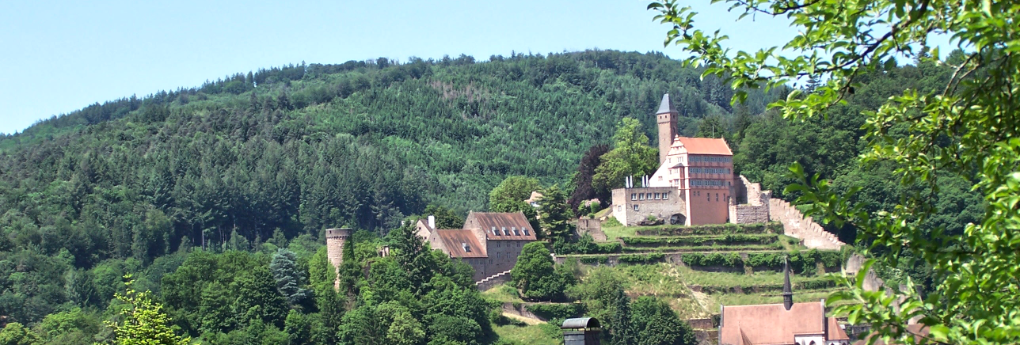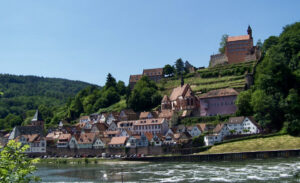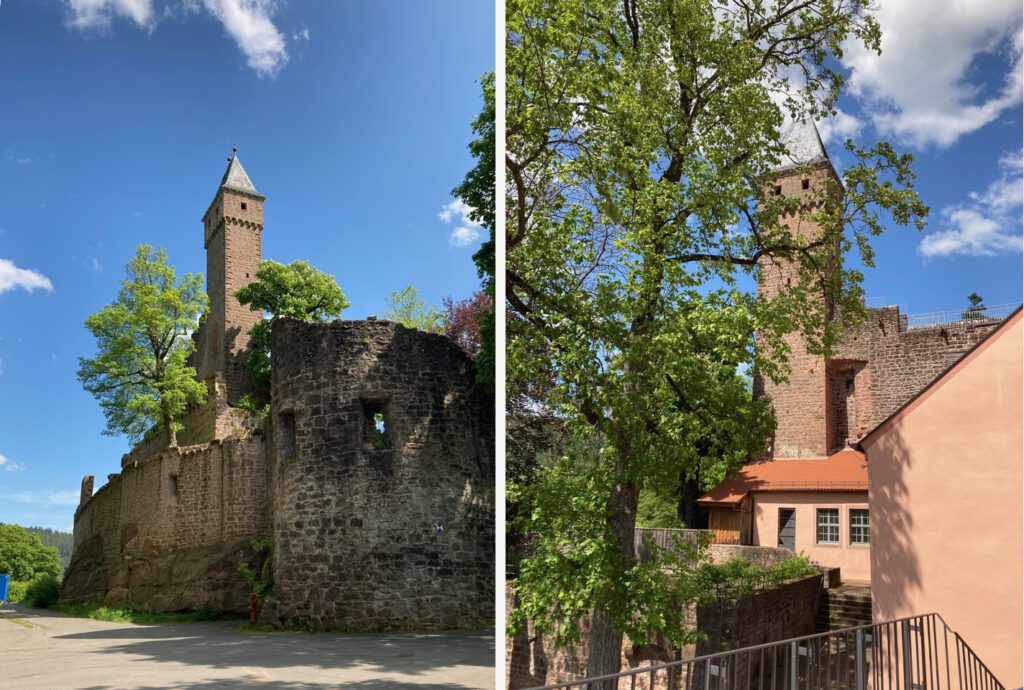
Hirschhorn Castle
 Hirschhorn the “Pearl of the Neckar Valley”. Here, the Neckar forms a tight double loop and creates the scenic feature of an extraordinary townscape. Surrounded by the city wall, the half-timbered houses of the old town nestle against the castle and monastery. The extensive complex, with its distinctive silhouette of walls, gables and tower, is one of the most beautiful in the Neckar Valley. Castle Hirschhorn is located above the old town its walls extend from the high castle ramparts past grassy lawns right down into the red roofs of the village below. The courtyard and tower can be visited. The castle can be reached within half an hour on foot, but there are also parking spaces directly at the castle complex. The small, recently restored castle chapel is a romantic place for civil weddings.
Hirschhorn the “Pearl of the Neckar Valley”. Here, the Neckar forms a tight double loop and creates the scenic feature of an extraordinary townscape. Surrounded by the city wall, the half-timbered houses of the old town nestle against the castle and monastery. The extensive complex, with its distinctive silhouette of walls, gables and tower, is one of the most beautiful in the Neckar Valley. Castle Hirschhorn is located above the old town its walls extend from the high castle ramparts past grassy lawns right down into the red roofs of the village below. The courtyard and tower can be visited. The castle can be reached within half an hour on foot, but there are also parking spaces directly at the castle complex. The small, recently restored castle chapel is a romantic place for civil weddings.
History
A ridge between the Neckar and Finkenbach valleys seemed to the lords of Hirschhorn to be the ideal location for their castle – the site and symbol of their rule in what is now the border region of Hesse and Baden-Württemberg. At first glance, the extensive castle or fortress complex hardly reveals that the core castle, consisting of a keep, narrow residential and farm buildings, and a massive shield wall, occupied only about one-twelfth of today’s area. It was built in the middle of the 13th century, when the Romanesque style slowly gave way to the Gothic; for there are remains of both round-arched Romanesque and pointed-arched Gothic windows.
Good revenues allowed expansion
In the 14th century, the lords of Hirschhorn began to expand their castle. They could afford it: from extensive property and through influential offices at the court of the Count Palatine, good money came into their coffers. Hirschhorn, like most castles of the time, was a small cosmos of its own that grew and grew. In addition to the knights and their families, gate and tower guards, hunters, grooms, shepherds, maids, servants, castle administrators and a clergyman lived in the castle. In addition to the residential buildings, there were stables and a barn (still partially preserved), as well as a beer house, a wash house, a bakehouse, a blacksmith’s shop, a building for storing game and a dog stable (no longer preserved). In 1350 the castle chapel was consecrated, civil marriages are performed today. From its original time, the north wall is still preserved, on which remains of a fresco depict scenes from the Passion of Christ, as told in the New Testament.
With the extensions of the 16th century, the people of Hirschhorn gave their castle more and more the character of a representative castle. This included the gardens facing the Neckar River with retaining walls, terraces and garden houses. Residential comfort also made its appearance: under Ludwig I von Hirschhorn (+1583) and his wife Maria von Hatzfeld, a magnificent building in the Renaissance style was erected, which is still called the Hatzfeldbau after its owner.
After the extinction of the Hirschhorn dynasty, the castle and dominion passed to the Electorate of Mainz, and from 1803 they belonged to the Landgraviate of Hesse-Darmstadt. The first repair measures at the end of the 19th century secured the building, which in the meantime had fallen into serious disrepair. At the end of the 1950s, a hotel was established in Hirschhorn Castle. During the most recent comprehensive monument preservation restoration work, the façade of the Hatzfeld Building was authentically renewed, among other things; inside, the architectural paintings of the Renaissance period were brought back to life. Hirschhorn now presents itself once again as a historic building that allows its visitors to experience the many facets of its construction and usage history.

